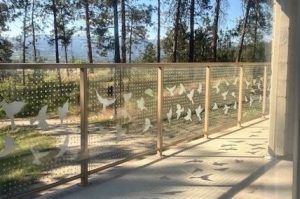
We are committed to fostering a bird-friendly campus environment by understanding the potential impact of bird-window collisions. We are undertaking a pilot program to monitor bird strikes during migratory periods. The insights gained from this program will help us tailor our approach to UBC’s Bird Friendly Design Guidelines for Buildings.
Why do birds collide with windows?
- Window reflections: mirror images of vegetation and open skies
- Migratory route: risk increases with windows along migratory route

University House guardrail with bird friendly film installed.
- Migratory season: risk increases during spring and fall
- Lights: birds often travel at night and are attracted to building lights
- Bird attractants: bird feeders or indoor plants near window attract birds
What is UBCO doing to reduce window collisions?
Responding to the Fall 2023 Bird Strike Monitoring pilot, UBC Okanagan initiated a project to install bird friendly film on the University House. The film was installed in late-June and will be monitored for effectiveness.
What can building occupants do to reduce window collisions?
- Be aware of bird attractants:
- Move plants away from windows
- Turn lights off or draw blinds after hours
- Increase the visibility of glass:
- Close curtains and blinds
- Report collisions
What do volunteers do?
- Walk around select campus buildings searching for bird strikes in the early morning during migratory seasons (20 mins/day)
- Report findings (10 mins/day)
- Spread awareness of bird strikes within your department and with building occupants who have outside windows
- To become a VOLUNTEER, apply HERE
Resources
- Report Bird Strike
- UBCO Bird Friendly Monitoring Program: Volunteer (poster.pdf)
- UBC has developed Bird Friendly Design Guidelines, referenced in the UBC Okanagan Design Guidelines – Green Building
- UBC Technical Guidelines (Section 08 80 00: Glazing)